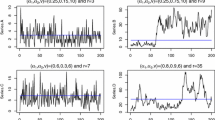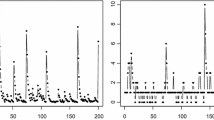Abstract
We introduce a two-parameter expectation thinning operator based on a linear fractional probability generating function. The operator is then used to define a first-order integer-valued autoregressive INAR (1) process. Distributional properties of the INAR (1) process are described. We revisit the Bernoulli-geometric INAR (1) process of Bourguignon and Weiß (Test 26(4):847–868, 2017. https://doi.org/10.1007/s11749-017-0536-4) and we introduce a new stationary INAR (1) process with a compound negative binomial distribution. Lastly, we show how a proper randomization of our operator leads to a generalized notion of monotonicity for distributions on \(\mathbf{Z}_+\).
Similar content being viewed by others
References
Alamatsaz MH (1993) On discrete \(\alpha \)-unimodal distributions. Stat Neerl 47:245–252
Al-Osh MA, Aly E-EAA (1992) First order autoregressive time series with negative binomial and geometric marginals. Commun Stat Theory Methods 21:2483–2492
Aly E-EAA, Bouzar N (1994) Explicit stationary distributions for some Galton–Watson processes with immigration. Commun Statist Stoch Models 10:499–517
Aly E-EAA, Bouzar N (1994b) On some integer-valued autoregressive moving average models. J Multivar Anal 50:132–151
Aly E-EAA, Bouzar N (2002) A notion of \(\alpha \)-monotonicity with generalized multiplications. Ann Inst Stat Math 54:125–137
Athreya KB, Ney PE (1972) Branching Processes. Springer, Berlin
Barreto-Souza W (2015) Zero-modified geometric INAR (1) process for modelling count time series with deflation or inflation of zeros. J Time Ser Anal 36:839–852
Bourguignon M, Weiß CH (2017) An INAR(1) process for modeling count time series with equidispersion, underdispersion and overdispersion. Test 26(4):847–868. https://doi.org/10.1007/s11749-017-0536-4
Borges P, Molinares FF, Bourguignon M (2016) A geometric time series model with inflated-parameter Bernoulli counting series. Stat Probab Lett 119:264–272
Borges P, Bourguignon M, Molinares FF (2017) A generalized NGINAR(1) process with inflated-parameter geometric counting series. Aust NZ J Stat 59:137–150
Foster JH, Williamson JA (1971) Limit theorems for the Galton–Watson process with time-dependent immigration. Z Wahrsch Verw Gebiete 20:227–235
Harris TE (1963) The theory of branching processes. Springer, Berlin
van Harn K, Steutel FW, Vervaat W (1982) Self-decomposable discrete distributions and branching processes. Z Wahrscheinlichkeitstheor Verw Gebiete 61:97–118
Jazi MA, Alamatsaz MH (2012) Two new thinning operators and their applications. Glob J Pure Appl Math 8:13–28
McKenzie E (2003) Discrete variate time series. Shanbhag DN et al. (ed) Stochastic processes: modelling and simulation. Handb Stat 21:573–606. Amsterdam, North-Holland
Ristić MM, Bakouch HS, Nastić AS (2009) A new geometric first-order integer-valued autoregressive (NGINAR(1)) process. J Stat Plan Inf 139:2218–2226
Scotto MG, Weiß CH, Gouveia S (2015) Thinning-based models in the analysis of integer-valued time series: a review. Stat Model 1515:590–618
Steutel FW (1988) Note on discrete \(\alpha \)-unimodality. Stat Neerl 48:137–140
Steutel FW, van Harn K (1979) Discrete analogues of self-decomposability and stability. Ann Probab 7:893–899
Weiß CH (2008) Thinning operations for modeling time series of countsa survey. AStA Adv Stat Anal 92(2008):319–341
Zhu R, Joe H (2003) A new type of discrete self-decomposability and its application to continuous-time Markov processes for modeling count data time series. Stoch Models 19:235–254
Author information
Authors and Affiliations
Corresponding author
Rights and permissions
About this article
Cite this article
Aly, EE.A.A., Bouzar, N. Expectation Thinning Operators Based on Linear Fractional Probability Generating Functions. J Indian Soc Probab Stat 20, 89–107 (2019). https://doi.org/10.1007/s41096-018-0056-x
Accepted:
Published:
Issue Date:
DOI: https://doi.org/10.1007/s41096-018-0056-x




